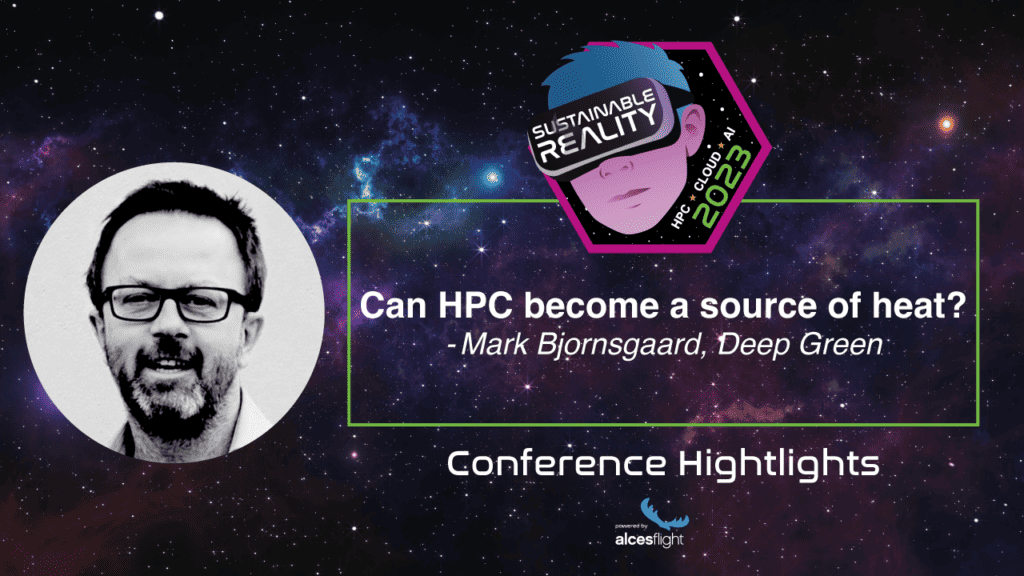Could HPC provide a heat source for the community?
This is part two of a six-part series on what sustainability means for the High Performance Computing Community. Click here to read Part One.
In 2011 a paper was published through a Microsoft Research team called, “The Data Furnace: Heating Up with Cloud Computing.” The authors of this paper posit that servers could be used to provide heat for homes, office buildings and industrial processes. They argued that the carbon footprint of the IT industry would be decreased substantially, that overall investment costs would come down (the servers, after all, could provide heat in exchange), and — as an added benefit — latency might be reduced (by placing the servers nearer to end-users).
In March of 2023, Deep Green proved the viability of the data furnace concept by partnering with a community swimming pool in Devon. Deep Green’s ‘micro data centre’ uses a heat exchange system to transform up to 96% of the energy that is consumed by their servers into warm water, ultimately reducing the leisure centre’s annual carbon footprint by 25.8 tonnes.
Alces Flight was pleased to welcome Mark Bjornsgaard, CEO of Deep Green, to this year’s Sustainable Reality event at the National Space Centre, where he gave us insights into the exciting work being undertaken by his company. Mark outlined the concepts of heat re-use in HPC, and presented his thoughts on the journey that the industry must go on — from heat adaption, to adoption, and finally… amalgamation. Here are the takeaways:
Data Centres, and HPC, consume a lot of electricity
The HPC community is acutely aware of the amount of power and cooling needed to keep its systems running. With the rapid growth of both AI and Machine Learning, electricity consumption is predicted to rise steeply over the coming years, with carbon emissions from HPC and AI rapidly exceeding those of the aviation industry. The question Deep Green seeks to answer, with a resounding ‘yes’, is whether the ‘waste’ heat generated by HPC can be put to good use. In the company’s view, we will soon enter the first phase of the transformation of the computing industry, called “Heat Adaption”. In this first phase, ‘data furnaces’ will be retro-fitted within existing buildings that might easily make use of waste heat — community swimming pools being a prime example, creating a win-win scenario for two quite-different communities.
Learn to capture and re-use the heat generated from compute, then scale the knowledge.
But Deep Green’s vision is not just to heat community pools — it is to start a movement that helps the world cope better with energy demand, and particularly electricity demand. In the “Heat Adoption” phase, Deep Green sees a transformation of the data centre sector, where computing resources are increasingly decentralised into ‘edge’ resources, not only to maximise opportunities for heat re-use, but also as a means to reduce load imbalance across the grid and provide better opportunities for using co-located solar and wind power, so helping to address the growing problem of energy security.
Taking re-use of heat globally and applying it to mixed-use communities.
Once we have got our heads around edge computing, heat re-use and increasingly-localised renewable power, the “Heat Amalgamation” phase of Deep Green’s vision isn’t too far-fetched. In this phase, data centres become an integral part of both urban planning and societal cohesion — with an increased focus on heat re-use for district heating systems, within existing industrial processes, for generating new industries (such as urban farming), and enabling new shared leisure spaces. By making a conscious effort to reclaim the waste heat from HPC and AI, there is the potential to meet our net zero targets much quicker, while creating new jobs and reimagining how communities might build and co-exist.

You can learn more about Deep Green and the work they do (including how they set up their micro data centres for best impact) here.
Get the full picture.
Would you like to see Mark’s full presentation? Check it out below:
Next time…
In our next part of the sustainability series dives deeper into renewable energy resources, and where the University of York is pioneering a shift towards cleaner, greener computing.


